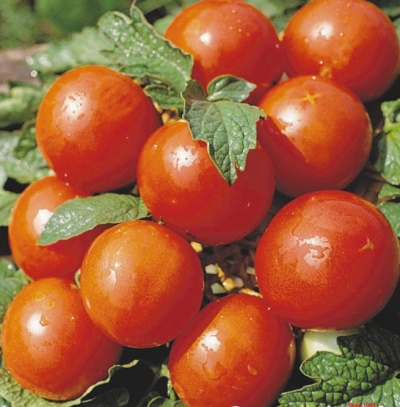
- Authors: Moldova
- Name synonyms: Perseus
- Category: grade
- Growth type: determinant
- Appointment: universal
- Ripening period: mid-early
- Ripening time, days: 105-123
- Growing conditions: for open ground, for film greenhouses
- Marketability: high
- Transportability: good
The Perseus variety is known to almost every Russian summer resident. This variety was bred by the efforts of Moldovan breeders over a hundred years ago. The tomato has become widespread due to its unpretentious care and strong immunity.
Description of the variety
A variety with a determinant type of growth is recommended for cultivation in the open air or in film greenhouses (hotbeds). The fruits have received a universal purpose. Low-growing bushes grow up to a maximum of 50-60 centimeters. They are vigorous plants with a dense and lush green mass. The foliage reliably protects tomatoes from direct sunlight. When the variety is grown in open areas, pollination occurs naturally, due to insects and wind. When cultivated in greenhouses, artificial pollination is used.
This variety belongs to the classic red tomatoes, which are well known to both experienced and novice gardeners. The variety grows in all climatic zones of the country. The variety is highly resistant to heat. The first inflorescence appears after 6 leaves. In each, from 4 to 6 fruits are formed.
The main qualities of the fruit
The color of whole ripe tomatoes is deep red. The color is uniform. The average weight of vegetables is 94-105 grams. Some of them grow up to 180 grams. Sizes are medium. The shape is rounded and flattened. Slight ribbing is observed. The fruits have good keeping quality, due to which vegetables can be stored for a long time. The first fruits grow the largest. The pulp is juicy and firm. The dry matter content is low. The number of seed chambers is from 5 to 7 pieces.
Vegetables are stored for a long time and do not deteriorate during transportation. Perseus tomatoes are often grown for sale. The fruits are used to prepare various dishes or are eaten fresh.
Taste characteristics
The gastronomic quality of the fruit is high. When canning, tomatoes do not lose their excellent taste characteristics.
Ripening and fruiting
Tomato Perseus is medium early. Ripening time - from 105 to 123 days.
Yield
High yield is one of the main positive characteristics of this variety. On average, 6 to 8 kilograms of vegetables are obtained per square meter of the garden. To achieve this result, it is enough just to follow the simple rules of agricultural technology. Under special conditions, the yield can be increased up to 9 kilograms.
The timing of planting seedlings and planting in the ground
Around the middle of March, gardeners begin to germinate seeds for seedlings. Seedlings are transferred to open ground in early June, and plants can be transferred under the film as early as mid-May.
The seed that was collected with your own hands must be disinfected. It is immersed in a potassium permanganate solution for 10-15 minutes. So that the seedlings appear as early as possible, the grains begin to germinate in gauze or cotton wool soaked in water. In the process of growing, the seedlings are divided into separate containers (each volume is 600 grams). Work is carried out 2-3 weeks after the start of sowing.
Young plants are hardened before planting in the garden. To do this, the container with sprouts is taken out into the street, increasing the time interval from day to day. During planting, the seedlings are buried 10 centimeters into the ground. The transplant cannot be carried out until the earth warms up after frost. To transfer the bushes to a new place, it is advisable to choose a calm and cool day.
A week later, the first watering is carried out. Until the ovary is formed, the seedlings are watered twice a week. Irrigation is then reduced to once every 7 days. Lack or excess moisture can cause cracks on the surface of the fruit.

Growing tomato seedlings is an extremely important process, because it largely depends on whether the gardener can harvest at all. All aspects must be taken into account, from seedbed preparation to planting in the ground.
Landing scheme
The most common landing pattern is 70x50 centimeters. Some gardeners arrange the plantation, leaving 40 centimeters between the plants, and place from 7 to 8 bushes on one square meter.

Growing and caring
Competent care is the key to a successful harvest. You need to take care of the tomato throughout the growing season.
The work consists in observing a number of conditions.
The bushes are irrigated infrequently, but abundantly. One adult bush consumes from 2 to 3 liters of clean and warm water.
Weeds should not grow on the site. They not only interfere with tomatoes, but also take nutrients and useful microelements from the soil.
In order for oxygen to reach the root system, the top layer of the earth is periodically loosened.
Treatment with prophylactic compositions, including fungicides, is carried out if necessary.
Fruit crops need fertilization. Nitrogen-based formulations are used in the growth process. During flowering, plants are sprayed with boron and magnesium, and during fruiting they switch to phosphorus or potassium.
Bushes form, despite their small size.
You can not overdo it with the amount of dressings. An excess of them is even more destructive for plants than a deficiency.




A plant needs different micronutrients at each stage of growth. All fertilizers can be divided into two groups: mineral and organic. Folk remedies are often used: iodine, yeast, bird droppings, eggshells.
It is important to observe the rate and period of feeding. This also applies to folk remedies and organic fertilizers.



























































































